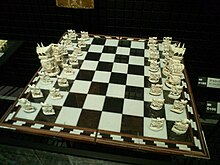古印度象棋

古印度象棋,或音译為恰圖蘭卡(梵語:चतुरङ्ग,caturaṅga),為古印度的一种象棋类游戏。该词在梵文caturaṅga是性状复合词,意为“有四肢或四部分”,在史詩中通常意为“軍隊”。[1] 起源於印度笈多时期的双人对弈棋類,歷史可追溯到西元前五、六世紀的八條盤碁,也有四人版變體,而直系後代為泰盧固象棋,此游戏為部分象棋遊戲的祖先。
六世紀時,印度人帶著此遊戲傳入波斯,而波斯人之後也帶波斯雙陸去印度[2]。


古印度象棋在本地發展為泰盧固象棋;往東則發展成泰國象棋、高棉象棋、緬甸象棋、馬來象棋、中國象棋、日本將棋等;往西发展成波斯象棋,在棋子和规则上有大规模的改进,开始在中亚各民族广为流传。
多兵種的棋類早在烏爾王族局戲就有,有雨燕、渡鴉、雞、鷹、家燕這五種棋子,但非以殺王為獲勝的局戲[3]。

威廉·瓊斯將古印度象棋的規則從梵語翻譯成英文。准确规则不详。象棋历史学家认为其规则与继任者波斯象棋类似。
規則
[编辑]棋盤
[编辑]- 棋盤為正方形,八乘八的方格,同於八條盤碁。
棋子
[编辑]- 棋子兵種有王(Raja)一個、仕[5](Mantri或Senapati)一個、象(Gaja)兩個、馬(Asva)兩個、車(Ratha)兩個、兵(Padàti或Bhata)八個。四種棋子反映了古印度军队的四種兵種[6]。《雜阿含經》:「天帝釋聞阿修羅王興四種兵:象兵、馬兵、車兵、步兵,來欲共戰。」
棋子配置
[编辑]棋子配置類似現在的國際象棋。王位置為己方左方數來第五行的底格,雙方王並不同行。仕的位置為己方左方數來第四行的底格。其餘兵種位置都相同。泰國象棋、高棉象棋、馬來象棋、衣索比亞象棋的棋子排列皆是兩王不同行;波斯象棋、蒙古象棋、西洋棋則是兩王同行。
| |||||||||||||||||||||||||||||||||||||||||||||||||||||||||||||||||||||||||
| 恰圖蘭卡初始布置[7]。 | |||||||||||||||||||||||||||||||||||||||||||||||||||||||||||||||||||||||||
棋子走法
[编辑]王走法與國際象棋的王相同,移動為周圍八格。
士走法與中國象棋的士相同,移動為右上、右下、左上、左下這四格。
象走法有好幾種描述。
- 同波斯象棋,與中國象棋的象類似,走田字形,但無塞象眼。
- 比魯尼在1030年描述走法是移動為上、右上、右下、左上、左下這五格。泰國象棋、高棉象棋、緬甸象棋、馬來象棋的象、日本將棋的銀將也同走法。
馬走法與國際象棋的馬相同,與中國象棋的馬相似(但無拐馬腳),移動為L字形。
車走法與國際象棋、中國象棋的車相同,移動為十字方向,不限步數。無國際象棋的王車易位規則。
兵走法與國際象棋的兵類似,吃法同為左上及右上,但兵的第一步時不能走兩步,無吃過路兵。升等只能升變为目的格的對應兵種,並且要該玩家已失去原先兵種的狀態。譬如己方兵到達b8(敵方馬之起始格)只能升變為馬,同時己方亦須有馬已失去,方能使用此「升變」該兵並「重召」為馬。 另一種升變規則是兵走到對方底線時,強制升變為士。
参考
[编辑]- ^ Meri 2005: 148
- ^ Wilkinson, Charles K. "Chessmen and Chess", The Metropolitan Museum of Art Bulletin. New Series 1:9, May 1943. pp. 271-279
- ^ Sacred Shapes and the Royal Game of Ur. [2013-05-23]. (原始内容存档于2013-08-20).
- ^ Chess for Beginners[永久失效連結]
- ^ 在西方翻譯為「皇后」。
- ^ 國際象棋 源起印度恰圖蘭卡棋?[永久失效連結]
- ^ The History Of Chess. ChessZone. [29 March 2011]. (原始内容存档于2020-09-05).
